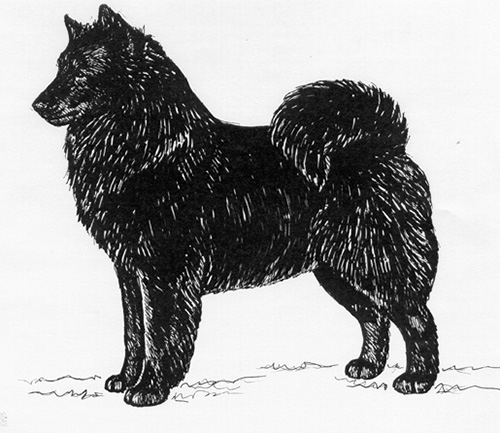Swedish Lapphund
Northern Breed Group
The goals and purposes of this breed standard include: to furnish guidelines for breeders who wish to maintain the quality of their breed and to improve it; to advance this breed to a state of similarity throughout the world; and to act as a guide for judges.
Breeders and judges have the responsibility to avoid any conditions or exaggerations that are detrimental to the health, welfare, essence and soundness of this breed, and must take the responsibility to see that these are not perpetuated.
Any departure from the following should be considered a fault, and the seriousness with which the fault should be regarded should be in exact proportion to its degree and its effect upon the health and welfare of the dog and on the dogs ability to perform its traditional work.
History
The Swedish Lapphund is a Nordic spitz breed that was originally used by the nomadic Laplanders for herding reindeer. It has been known in the Nordic regions for centuries. Today it is mainly used as a companion.
The Swedish Lapphund was recognized by the United Kennel Club in 2006.
General Appearance
A typical spitz type dog of slightly less than medium size, with proud head carriage, and a weather resistant coat.
Characteristics
The breed is very receptive and willing to work, and its abilities as a guard and herder made it very useful in the reindeer trade. They are lively, alert, kind and affectionate, easy to train and suitable for many different endeavors such as obedience, agility, herding and tracking.
Head
SKULL
The skull is slightly longer than it is wide. It is rounded at the forehead, and the occiput is not prominent. The stop is very well marked.
MUZZLE
The muzzle is a little more than a third of the total length of the head. It is strong, and tapers evenly towards the tip. The nasal bridge is straight. The lips are close fitting and strongly pigmented.
TEETH
The Swedish Lapphund has a complete set of evenly spaced, white teeth meeting in a scissors bite.
NOSE
The nose is preferably dark.
EYES
Round, fairly large, but not protruding, and set well apart, the eyes are preferably dark brown. They are full of expression, and have darkly pigmented rims.
EARS
The ears are small, triangular in shape, broad at the base, and rounded at the tips. They are set well apart and very mobile. Prick ears are desired but tipped ears are not an eliminating fault.
Neck
Medium length, clean cut, and powerful.
Forequarters
The shoulder blades are well laid back. There should be sufficient angulation at the shoulder joint and the elbow to provide good reach.
FORELEGS
The legs are straight, strong and parallel both standing and moving. The elbows are close to the chest. The pasterns slant enough to provide cushion.
Body
The body is compact and slightly longer than tall. The chest is deep to the elbow, and there is prominent forechest. The ribcage is long and oval, with well developed last ribs. The back is level, strong, muscular and springy. The loin is short and broad. The croup is proportionally long, broad and slightly sloping. The belly is slightly tucked up.
Hindquarters
The hindquarters are well angulated, but not exaggerated, at the hip, stifle and hock joints.
HIND LEGS
The upper thighs are muscular. The hocks are low set. Dewclaws are permissible.
Feet
The feet are oval, with tightly knit toes and hardy, elastic pads. They are well covered with fur, and the pads and nails are strongly pigmented.
Tail
Set rather high, the tail reaches to the hock when extended. It is carried curled over the back when the dog is moving.
Coat
There is a profuse double coat, with the outer coat standing straight off the body, and a dense, finely curled undercoat. The coat is longer on the brisket, back of legs and tail and forms a ruff around the neck.
Serious Fault: No trace of undercoat.
Color
The color is usually solid black. Some bronzing of the coat is typical. Liver was seen in the breed long ago. White on the chest, feet and tip of the tail is acceptable, but more white is undesirable.
Height
Height for males is 18-20 inches, with the ideal being 19. Height for females is 16-18 inches, with the ideal being 17.
Gait
Light, springy and ground covering.
Disqualifications
(A dog with a Disqualification must not be considered for placement in a conformation event, and must be reported to UKC.)
Unilateral or bilateral cryptorchid.
Viciousness or extreme shyness.
Albinism.

Looking for a Dog?
Find a dog that will fit your family.
Note: The breeders on this list are not endorsed by UKC.
Revised January 1, 2020. Dewclaws are permissible.
©Copyright 2006, United Kennel Club
